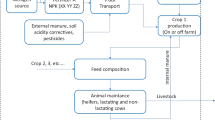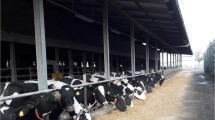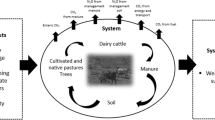Abstract
Milk production has been estimated to contribute 3–4% of anthropogenic greenhouse gas (GHG) emissions. However, the carbon footprint associated with raw milk can vary, depending on a variety of factors, such as the geographical area, species of cow and production system. In this study, a global overview of research published on the carbon footprint (CF) of raw cow milk is provided. Additionally, two different dairy systems (semi-confinement and pasture-based) have been analysed by life-cycle assessment (LCA) in order to determine their effect on the CF of the milk produced. Inventory data were obtained directly from these facilities, and the main factors involved in milk production were included (co-products, livestock food, water, electricity, diesel, cleaning elements, transport, manure and slurry management, gas emissions to air etc.). In agreement with reviewed literature, it was found that the carbon footprint of milk was basically determined by the cattle feeding system and gas emissions from the cows. The values of milk CF found in the systems under study were within the range for cow milk production worldwide (0.9–4.7 kgCO2eq kgFPCM−1). Specifically, in the semi-confinement and the pasture-based dairy farms, 1.22 and 0.99 kgCO2eq kgFPCM−1 were obtained, respectively. The environmental benefits obtained with the pasture grazing system are not only mainly due to the lower use of purchased fodder but also to the allocation between milk and meat that was found to be a determining methodological factor in CF calculation. Finally, data from the evaluated dairy systems have been employed to analyse the influence of raw milk production on cheese manufacturing. With this aim, the CF of a small-scale cheese factory has also been obtained. The main subsystems involved (raw materials, water, electricity, energy, cleaning products, packaging materials, transport, wastes and gas emissions) were included in the inventory of the cheese factory. CF values were 16.6 and 14.7 kgCO2eq kg−1 of cheese for milk produced in semi-confinement and pasture-based systems, respectively. The production of raw milk represented more than 60% of CO2eq emissions associated with cheese, so the primary production is the critical factor in reducing the GHG emissions due to cheese making.





Similar content being viewed by others
References
Abín R, Laca A, Laca A, Díaz M (2018) Environmental assessment of intensive egg production: a Spanish case study. J Clean Prod 179:160–168
Bakken AK, Daugstad K, Johansen A, Hjelkrem AGR, Fystro G, Strømman AH, Korsaeth A (2017) Environmental impacts along intensity gradients in Norwegian dairy production as evaluated by life cycle assessments. Agric Syst 158:50–60
Baldini C, Bava L, Zucali M, Guarino M (2018) Milk production life cycle assessment: a comparison between estimated and measured emission inventory for manure handling. Sci Total Environ 625:209–219
Basset-Mens C, Ledgard S, Boyes M (2009) Eco-efficiency of intensification scenarios for milk production in New Zealand. Ecol Econ 68:1615–1625
Batalla I, Knudsen MT, Mogensen L, del Hierro O, Pinto M, Hermansen JE (2015) Carbon footprint of milk from sheep farming systems in northern Spain including soil carbon sequestration in grass lands. J Clean Prod 104:121–129
Battini F, Agostini A, Tabaglio V, Amaducci S (2016) Environmental impacts of different dairy farming systems in the Po Valley. J Clena Prod 112:91–102
Bava L, Sandrucci A, Zucali M, Guerci M, Tamburini A (2014) How can farming intensification affect the environmental impact of milk production? J Dairy Sci 97:4579–4593
Belflower JB, Bernard JK, Gattie DK, Hancock DW, Risse LM, Rotz CA (2012) A case study of the potential environmental impacts of different dairy production systems in Georgia. Agric Syst 108:84–93
Boehm R, Wilde PE, Ver Ploeg M, Costello C, Cash SB (2018) A comprehensive life cycle assessment of greenhouse gas emissions from U.S. household food choices. Food Policy 79:67–76
Breton C, Blanchet P, Amor B, Beauregard R, Chang W-S (2018) Assessing the climate change impacts of biogenic carbon in buildings: a critical review of two main dynamic approaches. Sustainability 10:2020
Capper JL, Cady RA (2012) A comparison of the environmental impact of Jersey compared with Holstein milk for cheese production. J Dairy Sci 95:165–176
Canellada F, Laca A, Laca A, Díaz M (2018) Environmental impact of cheese production: A case study of a small-scale factory in southern Europe and global overview of carbon footprint. Sci Total Environ 635:167–177
Castanheira EG, Dias AC, Arroja L, Amaro R (2010) The environmental performance of milk production on a typical Portuguese dairy farm. Agric Syst 103:498–507
Chobtang J, Ledgard SF, McLaren SJ, Zonderland-Thomassen M, Donaghy DJ (2016) Appraisal of environmental profiles of pasture-based milk production: a case study of dairy farms in the Waikato region. New Zealand Int J Life Cycle Assess 21:311–325
Coates TW, Flesch TK, McGinn SM, Charmley E, Chen D (2017) Evaluating an eddy covariance technique to estimate point-source emissions and its potential application to grazing cattle. Agric For Meteorol 234–235:164–171
Colombini S, Zucali M, Rapetti L, Crovetto GM, Sandrucci A, Bava L (2015) Substitution of corn silage with sorghum silages in lactating cow diets: in vivo methane emission and global warming potential of milk production. Agric Syst 136:106–113
Dalgaard R, Schmidt J, Flysjö A (2014) Generic model for calculating carbon footprint of milk using four different life cycle assessment modelling approaches. J Clean Prod 73:146–153
Daneshi A, Esmaili-sari A, Daneshi M, Baumann H (2014) Greenhouse gas emissions of packaged fluid milk production in Tehran. J Clean Prod 80:150–158
De Oliveira G, Bourscheidt DS (2017) Multi-sectorial convergence in greenhouse gas emissions. J Environ Manag 196:402–410
Del Prado A, Mas K, Pardo G, Gallejones P (2013) Modelling the interactions between C and N farm balances and GHG emissions from confinement dairy farms in northern Spain. Sci Total Environ 465:156–165
European Commission (2018) https://ec.europa.eu/commission/index_en. .
EUROSTAT (2016). Milk and milk product statistics. Available from http://ec.europa.eu/eurostat. Accessed 9 October 2018.
Famiglietti J, Guerci M, Proserpio C, Ravaglia P, Motta M (2019) Development and testing of the Product Environmental Footprint Milk Tool: a comprehensive LCA tool for dairy products. Sci Total Environ 648:1614–1626
Fan X, Chang J, Ren Y, Wu X, Du Y, Xu R, Liu D, Chang SX, Meyerson LA, Peng C, Ge Y (2018) Recoupling industrial dairy feedlots and industrial farmlands mitigates the environmental impacts of milk production in China. Environ Sci Technol 52:3917–3925
Fantin V, Buttol P, Pergreffi R, Masoni R (2012) Life cycle assessment of Italian high quality milk production. A comparison with an EPD study. J Clean Prod 28:150–159
Food and Agriculture Organization of the United Nations (FAO) (2019) http://www.fao.org/dairy-production-products/products/milk-composition/en/. Accessed 20 May 2019.
Fathollahi H, Mousavi-Avval SH, Akram A, Rafiee S (2018) Comparative energy, economic and environmental analyses of forage production systems for dairy farming. J Clean Prod 182:852–862
Finnegan W, Yan M, Holden NM, Goggins J (2018) A review of environmental life cycle assessment studies examining cheese production. Int J Life Cycle Assess 23:1773–1787
Flysjö A, Henriksson M, Cederberg C, Ledgard S, Englund JE (2011) The impact of various parameters on the carbon footprint of milk production in New Zealand and Sweden. Agric Syst 104:459–469
Galloway C, Conradie B, Prozesky H, Esler K (2018a) Are private and social goals aligned in pasture-based dairy production? J Clean Prod 175:402–408
Galloway C, Conradie B, Prozesky H, Esler K (2018b) Opportunities to improve sustainability on commercial pasture-based dairy farms by assessing environmental impact. Agric Syst 166:1–9
GHGP (2017) Greenhouse Gas Protocol. Available from http://www.ghgprotocol.org/. Accessed 8 December 2017.
Gollnow S, Lundie S, Moore AD, McLaren J, van Buuren N, Stahle P, Christie K, Thylmann D, Rehl T (2014) Carbon footprint of milk production from dairy cows in Australia. Int Dairy J 37:31–38
Gunn JS, Ganz DJ, Keeton WS (2012) Biogenic vs. geologic carbon emissions and forest biomass energy production. GCB Bioenergy 4:239–242
Hospido A, Moreira MT, Feijoo G (2003) Simplified life cycle assessment of Galician milk production. Int Dairy J 13:783–796
IDF (International Dairy Federation) (2015) Bulletin of the IDF N479/2015: A common carbon footprint approach for the dairy sector—the IDF guide to standard life cycle assessment methodology: https://store.fil-idf.org/. Aaccessed 3 Mayo 2018.
ITER: Technological Institute of Renewable Energies (Spain) (2008) http://www.iter.es/. Accessed 11 September 2018.
Kiefer LR, Menzel F, Bahrs E (2015) Integration of ecosystem services into the carbon footprint of milk of South German dairy farms. J Environ Manag 152:11–18
Kristensen T, Søegaard K, Eriksen J, Mogensen L (2015) Carbon footprint of cheese produced on milk from Holstein and Jersey cows fed hay differing in herb content. J Clean Prod 101:229–237
Legard SF, Wei S, Wang X, Falconer S, Zhang N, Zhang X, Ma L (2019) Nitrogen and carbon footprints of dairy farm systems in China and New Zealand, as influenced by productivity, feed sources and mitigations. Agric Water Manag 213:155–163
Lorenz H, Reinsch T, Hess S, Taube F (2019) Is low-input dairy farming more climate friendly? A meta-analysis of the carbon footprints of different production systems. J Clean Prod 211:161–170
Misselbrook TH, Van Der Weerden TJ, Pain BF, Jarvis SC, Chambers BJ, Smith KA, Phillips VR, Demmers TGM (2000) Ammonia emission factors for UK agriculture. Atmos Environ 34:871–880
Morais T.G., Teixeira R.F.M., Rodrigues N.R., Domingos, T. (2018) Carbon Footprint of Milk from Pasture-Based Dairy Farms in Azores, PortugalSustainability, 10(10), 3658; https://doi.org/10.3390/su10103658
Noya I, González-García S, Berzosa J, Baucells F, Feijoo G, Moreira MT (2018) Environmental and water sustainability of milk production in Northeast Spain. Sci Total Environ 616-617:1317–1329
O’Brien D, Hennessy T, Moran B, Shalloo L (2015) Relating the carbon footprint of milk from Irish dairy farms to economic performance. J Dairy Sci 98:7394–7407
Ortiz-Gonzalo D, Vaast P, Oelofse M, de Neergaard A, Albrecht A, Rosenstock TS (2017) Farm-scale greenhouse gas balances, hotspots and uncertainties in smallholder crop-livestock systems in Central Kenya. Agric Ecosyst Environ 248:58–70
Patra AK (2017) Accounting methane and nitrous oxide emissions, and carbon footprints of livestock food products in different states of India. J Clean Prod 162:678–686
Rice P, O’Brien D, Shalloo L, Holden NM (2018) Defining a functional unit for dairy production LCA that reflects the transaction between the farmer and the dairy processor. Int J Life Cycle Assess 24:642–653
Rojas-Downing MM, Harrigan T, Nejadhashemi AP (2017) Resource use and economic impacts in the transition from small confinement to pasture-based dairies. Agric Syst 153:157–171
Röös E, Patel M, Spångberg J (2016) Producing oat drink or cow's milk on a Swedish farm—environmental impacts considering the service of grazing, the opportunity cost of land and the demand for beef and protein. Agric Syst 142: 23–32.
Santos HCM Jr, Maranduba HL, de Almeida Neto JA, Rodrigues LB (2017) Life cycle assessment of cheese production process in a small-sized dairy industry in Brazil. Environ Sci Pollut Res 24:3470–3482
Schueler M, Hansen S, Paulsen HM (2018a) Discrimination of milk carbon footprints from different dairy farms when using IPCC Tier 1 methodology for calculation of GHG emissions from managed soils. J Clean Prod 77:899–907
Schueler M, Paulsen HM, Berg W, Prochnow A (2018b) Accounting for inter-annual variability of farm activity data for calculation of greenhouse gas emissions in dairy farming. Int J Life Cycle Assess 23:41–54
Sejian V, Prasadh RS, Lees AM, Lees JC, Al-Hosni YAS, Sullivan ML, Gaughan JB (2018) Assessment of the carbon footprint of four commercial dairy production systems in Australia using an integrated farm system model. Carbon Manag 9:57–70
Soteriades AD, Gonzalez-Mejia AM, Styles D, Foskolos A, Moorby JM, Gibbons JM (2018) Effects of high-sugar grasses and improved manure management on the environmental footprint of milk production at the farm level. J Clean Prod 202:1241–1252
Styles D, Gonzalez-Mejia A, Moorby J, Foskolos A, Gibbons J (2018) Climate mitigation by dairy intensification depends on intensive use of spared grassland. Glob Chang Biol 24:681–693
Tabacco E, Comino L, Borreani G (2018) Production efficiency, costs and environmental impacts of conventional and dynamic forage systems for dairy farms in Italy. Eur J Agron 99:1–12
Teagasc (2015) Moorepark ‘15. Irish dairying—sustainable expansion.https://www.teagasc.ie/media/website/publications/2015/Irish_Dairying-Sustainable_Expansion_Moorepark15.pdf. Accessed 20 May 2019
Thoma G, Popp J, Shonnard D, Nutter D, Matlock M, Ulrich R, Kellogg W, Kim DS, Neiderman Z, Kemper N, Adom F, East C (2013) Regional analysis of greenhouse gas emissions from USA dairy farms: a cradle to farm-gate assessment of the American dairy industry circa 2008. Int Dairy J 31:S29–S40
Thomassen MA, Dolman MA, van Calker KJ, de Boer IJM (2009) Relating life cycle assessment indicators to gross value added for Dutch dairy farms. Ecol Econ 8–9:2278–2286
Todde G, Murgia L, Caria M, Pazzona A (2018a) A Comprehensive energy analysis and related carbon footprint of dairy farms. Part 1: investigation and modeling of indirect energy requirements. Energies 11:451
Todde G, Murgia L, Caria M, Pazzona A (2018b) A Comprehensive energy analysis and related carbon footprint of dairy farms. Part 2: investigation and modeling of indirect energy requirements. Energies 11:463
Toro-Mujica P, Aguilar C, Vera RR, Bas F (2017) Carbon footprint of sheep production systems in semi-arid zone of Chile: a simulation-based approach of productive scenarios and precipitation patterns. Agric Syst 157:22–38
United Nations Development Program (UNDP) (2018) http://www.undp.org/. Accessed 3 May 2018.
Vasilaki V, Katsou E, Ponsá S, Colón J (2016) Water and carbon footprint of selected dairy products: A case study in Catalonia. J Clean Prod 139:504–516
Veltman K, Rotz CA, Chase L, Cooper J, Ingraham P, Izaurralde RC, Jones CD, Gaillard R, Larsoni RA, Ruark M, Salas W, Thoma G, Jollieta O (2018) A quantitative assessment of beneficial management practices to reduce carbon and reactive nitrogen footprints and phosphorus losses on dairy farms in the US Great Lakes region. Agric Syst 166:10–25
Vergé XPC, Maxime D, Dyer JA, Desjardins RL, Arcand Y, Vanderzaag A (2013) Carbon footprint of Canadian dairy products: Calculations and issues. J Dairy Sci 96:6091–6104
Wang X, Ledgard S, Lou J, Guo Y, Zhao Z, Guo L, Liu S, Zhang N, Duan X, Ma L (2018) Environmental impacts and resource use of milk production on the North China Plain, based on life cycle assessment. Sci Total Environ 625:486–495
Weiler V, Udo HMJ, Viets T, Crane TA, De Boer IJM (2014) Handling multi-functionality of livestock in a life cycle assessment: the case of smallholder dairying in Kenya. Curr Opin Environ Sustain 8:29–38
Weiss F, Leip A (2012) Greenhouse gas emissions from the EU livestock sector: a life cycle assessment carried out with the CAPRI model. Agric Ecosyst Environ 149:124–134
Woldegebriel D, Udo H, Viets T, van der Harst E, Potting J (2017) Environmental impact of milk production across an intensification gradient in Ethiopia. Livest Sci 206:28–36
Xu X, Lan Y (2016) A comparative study on carbon footprints between plant- and animal-based foods in China. J Clean Prod 112:2581–2592
Yan MJ, Humphreys J, Holden NM (2013) Life cycle assessment of milk production from commercial dairy farms: the influence of management tactics. J Dairy Sci 96:4112–4124
Yue Q, Xu X, Hillier J, Cheng K, Pan G (2017) Mitigating greenhouse gas emissions in agriculture: from farm production to food consumption. J Clean Prod 149:1011–1019
Zhao R, Xu Y, Wen X, Zhang N, Cai J (2018) Carbon footprint assessment for a local branded pure milk product: a lifecycle based approach. Food Sci Technol 38:98–105
Acknowledgements
‘La Praviana’ (Salas, Asturias) and ‘La Baraya’ (Infiesto, Asturias) dairy farms and ‘Ca Llechi’ cheese factory (Moruxones, Pintueles. Piloña 33540 Asturias) and especially, Alberto Valiente, are gratefully acknowledged for kind collaboration and for supplying the data employed in this research.
Funding
This study was carried out thanks to funding from the Employment, Industry and Tourism Office of the Principality of Asturias (Spain) through project IDI/2018/000127.
Author information
Authors and Affiliations
Corresponding author
Additional information
Responsible editor: Philippe Garrigues
Publisher’s note
Springer Nature remains neutral with regard to jurisdictional claims in published maps and institutional affiliations.
Rights and permissions
About this article
Cite this article
Laca, A., Gómez, N., Laca, A. et al. Overview on GHG emissions of raw milk production and a comparison of milk and cheese carbon footprints of two different systems from northern Spain. Environ Sci Pollut Res 27, 1650–1666 (2020). https://doi.org/10.1007/s11356-019-06857-6
Received:
Accepted:
Published:
Issue Date:
DOI: https://doi.org/10.1007/s11356-019-06857-6




